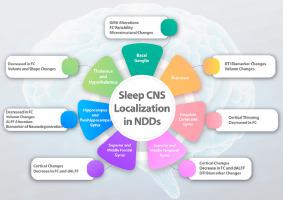Psychiatry Research: Neuroimaging ( IF 2.3 ) Pub Date : 2023-10-20 , DOI: 10.1016/j.pscychresns.2023.111727 Sana Mohammadi , Mahdi Mohammadi , Sadegh Ghaderi

|
Sleep disruptions associated with neurodegenerative diseases (NDDs) damage the brain's sleep-regulating regions. Advanced magnetic resonance imaging (MRI) techniques can characterize the signature of each neurodegenerative pathology. We performed an evaluation of sleep-related regions in NDDs using MRI to localize the central nervous system (CNS).
In the initial search, 61 related papers were discovered using predetermined inclusion and exclusion criteria. Finally, 30 articles were included in this study. The study included patients with Parkinson's disease (PD), Alzheimer's disease (AD), multiple sclerosis (MS), rapid eye movement (REM) sleep behavior disorder (RBD), idiopathic RBD (iRBD), amyotrophic lateral sclerosis (ALS), and mild cognitive impairment (MCI).
Sleep-related regions recognized by CNS localization in NDDs can be linked to important regions. MRI also revealed cortical thinning, GM atrophy, WM, and tract loss, changes in diffusion tensor imaging (DTI) biomarkers (fractional anisotropy (FA), axial diffusivity (Da), and radial diffusivity (Dr)), a decrease in DMN connectivity, a reduction in functional connectivity (FC), and amplitude of low-frequency fluctuation (ALFF) alterations.
Sleep plays an important role in predicting future risks for the development of NDDs. Other neuroimaging, cognitive-behavioral, and clinical research can use the information found in this research about the brain regions, MRI biomarker changes, and their relationships.
中文翻译:

使用磁共振成像通过中枢神经系统定位神经退行性疾病中的睡眠相关区域
与神经退行性疾病 (NDD) 相关的睡眠中断会损害大脑的睡眠调节区域。先进的磁共振成像 (MRI) 技术可以表征每种神经退行性病理学的特征。我们使用 MRI 来定位中枢神经系统 (CNS),对 NDD 中的睡眠相关区域进行了评估。
在最初的搜索中,使用预定的纳入和排除标准发现了 61 篇相关论文。最终,本研究纳入 30 篇文章。该研究包括帕金森病 (PD)、阿尔茨海默病 (AD)、多发性硬化症 (MS)、快速眼动 (REM) 睡眠行为障碍 (RBD)、特发性 RBD (iRBD)、肌萎缩侧索硬化症 (ALS) 和轻度认知障碍(MCI)。
NDD 中中枢神经系统定位识别的睡眠相关区域可以与重要区域联系起来。MRI 还显示皮质变薄、GM 萎缩、WM 和束丢失、扩散张量成像 (DTI) 生物标志物(分数各向异性 (FA)、轴向扩散率 (Da) 和径向扩散率 (Dr))的变化、DMN 连接性降低、功能连接(FC)减少和低频波动(ALFF)变化幅度。
睡眠在预测 NDD 未来发展风险方面发挥着重要作用。其他神经影像、认知行为和临床研究可以使用本研究中发现的有关大脑区域、MRI 生物标志物变化及其关系的信息。



























 京公网安备 11010802027423号
京公网安备 11010802027423号